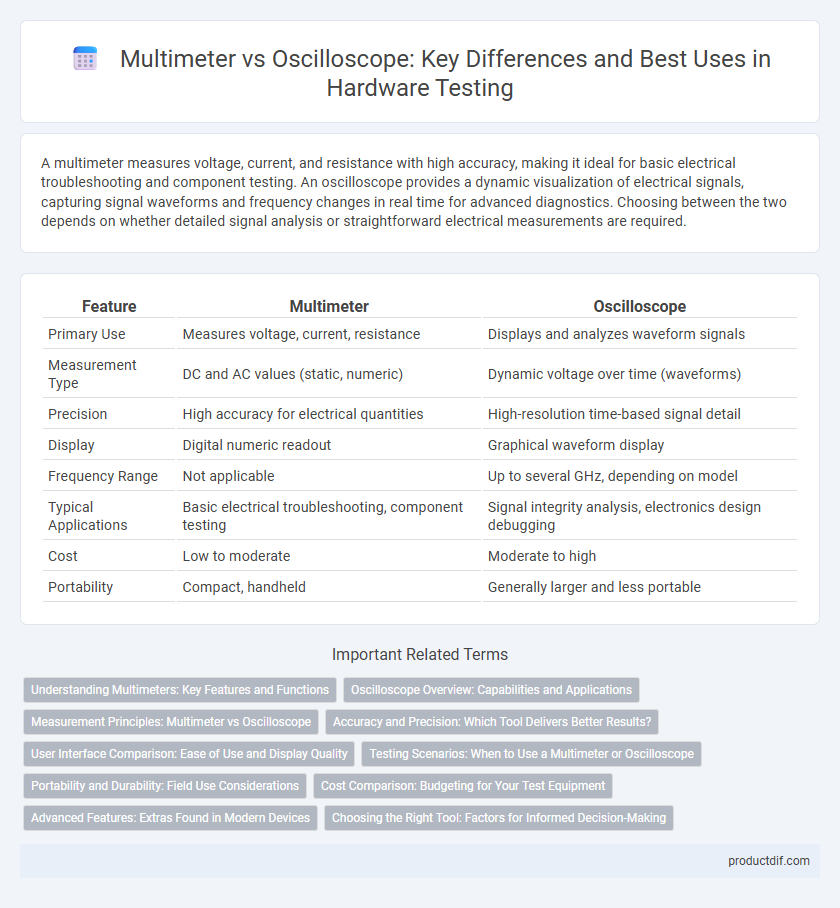A multimeter measures voltage, current, and resistance with high accuracy, making it ideal for basic electrical troubleshooting and component testing. An oscilloscope provides a dynamic visualization of electrical signals, capturing signal waveforms and frequency changes in real time for advanced diagnostics. Choosing between the two depends on whether detailed signal analysis or straightforward electrical measurements are required.
Table of Comparison
| Feature | Multimeter | Oscilloscope |
|---|---|---|
| Primary Use | Measures voltage, current, resistance | Displays and analyzes waveform signals |
| Measurement Type | DC and AC values (static, numeric) | Dynamic voltage over time (waveforms) |
| Precision | High accuracy for electrical quantities | High-resolution time-based signal detail |
| Display | Digital numeric readout | Graphical waveform display |
| Frequency Range | Not applicable | Up to several GHz, depending on model |
| Typical Applications | Basic electrical troubleshooting, component testing | Signal integrity analysis, electronics design debugging |
| Cost | Low to moderate | Moderate to high |
| Portability | Compact, handheld | Generally larger and less portable |
Understanding Multimeters: Key Features and Functions
Multimeters measure voltage, current, and resistance, providing essential diagnostic capabilities for electrical circuits and components. Key features include digital or analog displays, continuity testing, diode testing, and the ability to measure both AC and DC signals. Their multifunctional design makes multimeters indispensable for troubleshooting electrical problems in hardware projects and maintenance tasks.
Oscilloscope Overview: Capabilities and Applications
An oscilloscope is an essential diagnostic tool in electronics, offering real-time visualization of electrical signals with high-frequency bandwidth and time resolution capabilities. It enables the measurement of voltage waveforms, frequency, rise time, and signal integrity, making it indispensable for analyzing complex circuits and troubleshooting hardware issues. Common applications include testing analog and digital signals, designing embedded systems, and validating communication protocols in both industrial and research environments.
Measurement Principles: Multimeter vs Oscilloscope
A multimeter measures electrical parameters such as voltage, current, and resistance using direct and alternating current sensing with integrated circuits and analog-to-digital converters, providing numerical values on a digital display. An oscilloscope captures and visualizes time-varying electrical signals by sampling voltage over time, displaying waveform shapes and signal characteristics on a screen for detailed analysis. While multimeters offer steady-state quantitative measurements, oscilloscopes reveal dynamic signal behavior critical for frequency, amplitude, and waveform shape assessment.
Accuracy and Precision: Which Tool Delivers Better Results?
Oscilloscopes provide higher accuracy in capturing dynamic voltage changes with precise time resolution, making them ideal for analyzing complex waveforms and transient signals. Multimeters offer reliable precision for steady-state voltage, current, and resistance measurements but lack the high-frequency detail and temporal accuracy of oscilloscopes. For applications demanding precise waveform visualization and transient analysis, oscilloscopes deliver superior measurement accuracy compared to standard multimeters.
User Interface Comparison: Ease of Use and Display Quality
Multimeters feature simple, intuitive user interfaces with straightforward rotary dials and digital displays, making them accessible for quick measurements and basic diagnostics. Oscilloscopes provide complex, high-resolution color screens with customizable waveform views and multiple control knobs, which require more expertise but offer detailed signal analysis. The display quality of oscilloscopes surpasses multimeters by delivering precise visual representations of electrical signals, crucial for advanced troubleshooting.
Testing Scenarios: When to Use a Multimeter or Oscilloscope
Use a multimeter for basic electrical measurements such as voltage, current, and resistance in circuits where static or DC values need verification. Choose an oscilloscope when analyzing dynamic signals, waveforms, and frequency changes in complex or time-varying electronic systems. Practical testing scenarios include using a multimeter for battery testing or continuity checks, while oscilloscopes excel in diagnosing transient faults, signal integrity issues, and waveform distortions.
Portability and Durability: Field Use Considerations
Multimeters excel in portability due to their compact design and lightweight construction, making them ideal for quick field diagnostics and on-the-go measurements. Oscilloscopes, especially handheld models, balance portability with advanced functionality but often weigh more and require careful handling to avoid damage. Durability in multimeters typically includes rugged, impact-resistant casings suited for harsh environments, whereas oscilloscopes may need additional protective accessories to ensure reliability during field use.
Cost Comparison: Budgeting for Your Test Equipment
Multimeters typically cost between $20 and $200, making them a budget-friendly option for basic electrical measurements like voltage, current, and resistance. Oscilloscopes range from $200 to over $5,000, reflecting their advanced capabilities for visualizing signal waveforms and diagnosing complex circuit behavior. Choosing between a multimeter and an oscilloscope depends on balancing the precision and functionality needed against the available budget for test equipment.
Advanced Features: Extras Found in Modern Devices
Modern multimeters offer advanced features such as auto-ranging, data logging, and Bluetooth connectivity for remote monitoring, enhancing ease of use and data accuracy. Oscilloscopes provide superior waveform analysis with features like high sampling rates, deep memory, and advanced trigger functions, enabling detailed signal inspection. Specialized functions in oscilloscopes, including FFT analysis and protocol decoding, cater to complex diagnostics beyond the capabilities of traditional multimeters.
Choosing the Right Tool: Factors for Informed Decision-Making
Selecting between a multimeter and an oscilloscope depends on the specific measurement needs; a multimeter excels in precise voltage, current, and resistance readings, while an oscilloscope provides detailed waveform analysis and signal timing. Consider factors such as the type of electrical signals, required measurement accuracy, and budget constraints to determine the appropriate diagnostic instrument. Understanding device specifications, like sampling rate for oscilloscopes and input impedance for multimeters, ensures optimal tool selection for effective hardware troubleshooting and design validation.
Multimeter vs Oscilloscope Infographic

 productdif.com
productdif.com